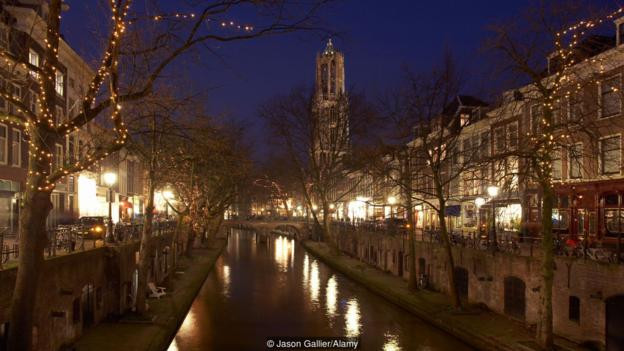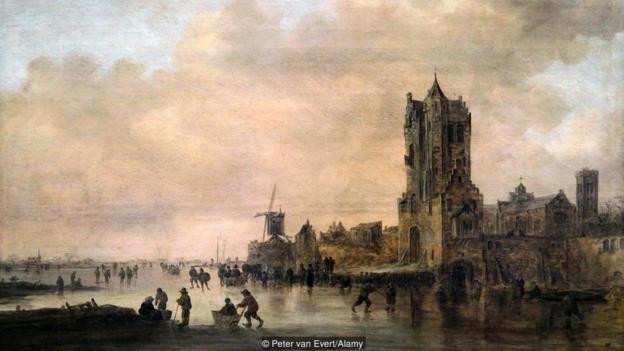Strange storm broke the whole city in 1674
Just 15 minutes short, a violent and powerful storm swept across northwest Europe on a summer night of nearly 350 years ago. This storm left a strong imprint in the social life and architecture of the city of Utrecht and is still visible today.
A new study has just been done, helping analyze and reconstruct the evolution and destruction of the old storm. At the end of the 17th century was a challenging time for the Dutch, they were in the midst of the situation against the forces from outside, including Britain and France.
1672 was a memorable year in Dutch history, it was called the "Year of the Catastrophe" because it marked the invasion of England, France and part of Germany today into the Dutch Republic.
The French had already cleaned up valuable things in Utrecht and unfortunately, just two years later, a disaster struck and the Dutch had nothing left to defend.

The city of Utrecht of the Netherlands today, nearly 350 years after a series of events.(Photo: Jason Gallier).
The first Wednesday of August 1674, was a warm but rather humid summer day in northwestern Europe. But at the end of the day, a strong storm formed and grew bigger and bigger.
This is an unusual and rare weather phenomenon in the summer in this land. By 6 pm, the storm was too strong, it walked along the northern part of the area and left a deep mark on the ground whenever it passed.
An ancient church with two large towers was swept away, only a few hours earlier it stood still majestically. A lot of people were there and watched the incident with their eyes.
A newspaper recorded: ' In Brussels, hail fell heavily and as large as marble, many trees were uprooted and sucked into the air, many houses were toppled while many other houses were blown up. . In Strassbourg, hail falls massively, the stone is as big as a child's head. "

Painting depicts the horrifying spectacle of the evening of 1/8/1674 by painter Jan van Goyen.
Dutch merchant Gerrit Jansz Kooch also witnessed the storm and wrote a poem describing the scene that day, that the boats were not anchored on the water at the river bank, but flew into the sky and were thrown into the wings. copper is nearby and stranded forever.
The farmers no longer know what their fields are, because the trees and the piles are absorbed by the storm and fly away.
Utrecht suffered immensely from the historic storm, the effects of natural disasters can be easily seen today.
Researcher Gerard van der Schrier of the Royal Dutch Meteorological Institute said: ' Dom Cathedral is a living evidence for the incident, the storm has struck it directly. Now the main tower of the Church lies in the middle of the main room, around it is a large space before the remaining spaces of the Church. That empty space is the part that the storm takes away. "

The main tower of Dom Cathedral is alone among the devastated spaces of the church by the evil monster storm.(Painting by H. van Kessel).
That is strong and intense, but the damage left is controversial.
While the front houses were completely destroyed, the inner houses right next to them were still normal, not damaged even if only a brick. Many other places in the city also noted a similar situation, when the damage was different in different areas even though not too far apart.
In addition, the time of the storm was extremely short, only 15 minutes. Van der Schrier said many farmers were too scared to lie on the fields in hopes of holding something, but only a few minutes later they felt no more wind, they stood up and saw the clear sky.
Talking about this event, meteorologists in 1980 assumed that the damage in Utrecht was due to a tornado. Only a tornado is capable of destroying a certain area along the path it passes, and ends quickly after a short time.
However, Van der Schrier and his partner Rob Groenland said there was a better explanation for the disaster than in the past.
The problem is that tornadoes only take place in a specific area, it can break a small district but cannot clean up a large, bustling metropolis in northwestern Europe.
A term used to refer to a new form of storms, called bow echo, could be explained for the phenomenon in 1674. This term was only used about 40 years ago when the radar system The weather began to be widely used.
Bow echo means echoes in an arc, weather radar will listen to the echo of the storm and help researchers identify details about it.

Bow echo causes extreme and extremely dangerous weather events.(Photo by Mike Hollingshead).
The weather- captured radar- shaped storm clouds are often very large in size, in fact they can span dozens or hundreds of kilometers. They pulled through an area within an hour, inside it had strong winds and blew in a straight line. The wind ran straight and parallel to the ground at high speed, then gradually lowered its altitude and reached the ground.
Van der Schrier said, can simulate the historic storm based on the recount of witnesses. In straight winds, if their winds are different, they will create different, small winds.
In fact, the Dom Cathedral and other church towers collapsed in the north, while other buildings were blown westward, ie the path of the wind perpendicular to each other, this is a sign of A big storm has an arc shape.

A bow echo on the sky of the US state of South Dakota.(Photo by Mike Hollingshead).
Van der Schrier's work is very important and is concerned by the Dutch authorities, because they want to protect the works of the big cities from storms that appear less but serious.
'We did not have the opportunity to witness it firsthand to study this weather phenomenon, they rarely appeared but it was fortunate that the storm of 1674 was witnessed by many witnesses and the evidence left. today, " said Schrier.
Because it happened right after the war in 1672, the city did not have enough funds to repair the damaged buildings. At this time the city became deserted and deserted, gay people who always received a look of disdain from society, had the opportunity to live together at damaged buildings.
50 years later, the city government knew about it, and suppressed gay activities, starting from the Utrecht Central Cathedral. This crackdown became famous in the history of war and devastating storm.

Painting of scenes of gay repression in Utrecht 50 years after the storm occurred.
Today, the word Utrechtenaar in Dutch is synonymous with homosexuality, taken from the name of the city of Utrecht, and many people believe that it is the place where all the sexual activities of gay people in the Netherlands begin. until today.
This city witnessed many events in history that today its influence is still enormous.
- Storm 'like apocalypse' attacked the Russian city
- Big storm broke out on the sun
- Discovering the 'strange black shadow' in the midst of a storm in America
- The dusty wall 'devoures' the Indian city
- 'Strange' path of storm No. 4
- expert of Hunt Storm has dead by the storm
- Blizzard 'devour' Siberia city in the cold of -50 degrees Celsius
- This is what happens if the Sun storm is strong enough to erase the technology of mankind
- Hurricane 6 suddenly turned, headed into the Gulf of Tonkin
- Warning: Storm No. 2 intensifies, Hanoi rains heavily this afternoon
- Video: Strange clouds cover the city of Argentina causing panic
- 'The first time he broke his forehead', broke the TV because of Nintendo Wii
 'Fine laughs' - Scary and painful torture in ancient times
'Fine laughs' - Scary and painful torture in ancient times The sequence of numbers 142857 of the Egyptian pyramids is known as the strangest number in the world - Why?
The sequence of numbers 142857 of the Egyptian pyramids is known as the strangest number in the world - Why? History of the iron
History of the iron What is alum?
What is alum?